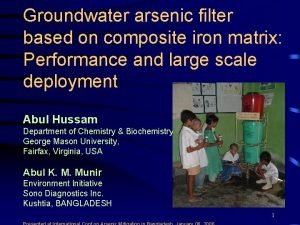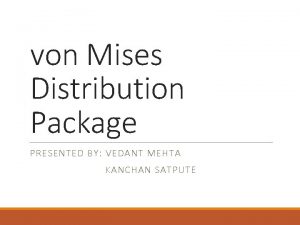Implementation of the Kanchan TM Arsenic Filter in

- Slides: 1

Implementation of the Kanchan. TM Arsenic Filter in Rural Nepal Susan Murcott, Massachusetts Institute of Technology (murcott@mit. edu) The Problem Although access to safe drinking is a basic human right, 1. 1 billion people in the world are denied this right. Two of the most common drinking water contaminants in the developing world are arsenic and pathogens. Arsenic is a poison that causes skin lesions and cancer. Water-borne pathogens, such as viruses and bacteria, can cause diarrhea, cholera, stunting, etc. It is estimated that 0. 7 millions in rural Nepal are affected by arsenic, and many more by pathogens. Despite growing recognition of the immediacy of this crisis, many previous aid projects have failed in rural areas because of the choice of unsustainable technologies and/or inappropriate implementation. As a result, people have no choice but to continue to drink unsafe water. Often women and children are most vulnerable to these preventable waterborne diseases. Children drinking directly from a tube well The Solution A team comprised of researchers at Massachusetts Institute of Technology and two Nepali NGO partners (ENPHO and RWSSSP) developed a low-cost (US$16), innovative household water filter, the Kanchan. TM Arsenic Filter (KAF), constructed using locally available labor and materials. The design is optimized based on the socioeconomic conditions in rural Nepal. Achievements Diffuser Basin Lid Brick chips Container Iron Nails Water Pipe Fine Sand Coarse Sand Gravel The components of the KAF The KAF design and implementation won a US$10, 000 award at the MIT IDEAS Competition 2002 and a US$115, 000 award at the World Bank Development Marketplace Competition 2003. In 2004, the team established an in-country technology dissemination and implementation center and built local capacity in arsenic-affected villages towards long-term, self-reliant, user-participatory safe water provision, involving training of local women, entrepreneurs, trainers, teachers, and authorities. A total of 26 entrepreneurs from 10 arsenic-affected districts have been trained in filter construction, operation, and maintenance techniques. Education and capacitybuilding workshops have been conducted in 150 villages. Over 1, 000 KAFs have been distributed by agencies including the Nepal Red Cross Society, RWSSSP, Filters for Families, Department of Education, Rural Water Supply Fund Development Board, etc. It is expected by Dec 2004, over 2, 000 KAFs will be in use, serving over 15, 000 people. Evaluation on this project is showing excellent technical performance. Users express strong acceptance and satisfaction of the KAF. Prominent NGOs in Nepal and the Nepali government consider the KAF as the best among all household filters available. KAF in operation Education workshop in the village of Kunwar Next Steps Building on the success of the 2004 implementation activities, we are seeking funding now for additional education and capacity-building programs to be conducted in 2005 and beyond to reach the rest of the affected population in Nepal and beyond. Acknowledgements: MIT Nepal Water Project, MIT Dept. of Civil and Environmental Engineering, Lemelson Foundation, MIT IDEAS Competition & PSC, The World Bank, Stanford University, Japanese Red Cross Society, NRCS, RWSSFDB, Filters for Families, Kathmandu University, Tribhuvan University, ENPHO, RWSSSP

